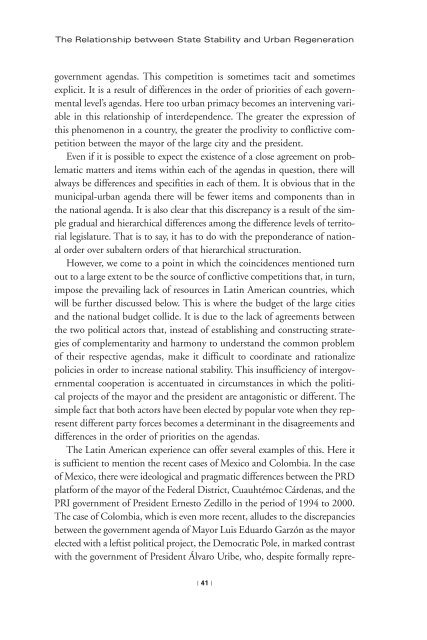urban regeneration and revitalization in the americas - Woodrow ...
urban regeneration and revitalization in the americas - Woodrow ...
urban regeneration and revitalization in the americas - Woodrow ...
You also want an ePaper? Increase the reach of your titles
YUMPU automatically turns print PDFs into web optimized ePapers that Google loves.
The Relationship between State Stability <strong>and</strong> Urban Regeneration<br />
government agendas. This competition is sometimes tacit <strong>and</strong> sometimes<br />
explicit. It is a result of differences <strong>in</strong> <strong>the</strong> order of priorities of each governmental<br />
level’s agendas. Here too <strong>urban</strong> primacy becomes an <strong>in</strong>terven<strong>in</strong>g variable<br />
<strong>in</strong> this relationship of <strong>in</strong>terdependence. The greater <strong>the</strong> expression of<br />
this phenomenon <strong>in</strong> a country, <strong>the</strong> greater <strong>the</strong> proclivity to conflictive competition<br />
between <strong>the</strong> mayor of <strong>the</strong> large city <strong>and</strong> <strong>the</strong> president.<br />
Even if it is possible to expect <strong>the</strong> existence of a close agreement on problematic<br />
matters <strong>and</strong> items with<strong>in</strong> each of <strong>the</strong> agendas <strong>in</strong> question, <strong>the</strong>re will<br />
always be differences <strong>and</strong> specifities <strong>in</strong> each of <strong>the</strong>m. It is obvious that <strong>in</strong> <strong>the</strong><br />
municipal-<strong>urban</strong> agenda <strong>the</strong>re will be fewer items <strong>and</strong> components than <strong>in</strong><br />
<strong>the</strong> national agenda. It is also clear that this discrepancy is a result of <strong>the</strong> simple<br />
gradual <strong>and</strong> hierarchical differences among <strong>the</strong> difference levels of territorial<br />
legislature. That is to say, it has to do with <strong>the</strong> preponderance of national<br />
order over subaltern orders of that hierarchical structuration.<br />
However, we come to a po<strong>in</strong>t <strong>in</strong> which <strong>the</strong> co<strong>in</strong>cidences mentioned turn<br />
out to a large extent to be <strong>the</strong> source of conflictive competitions that, <strong>in</strong> turn,<br />
impose <strong>the</strong> prevail<strong>in</strong>g lack of resources <strong>in</strong> Lat<strong>in</strong> American countries, which<br />
will be fur<strong>the</strong>r discussed below. This is where <strong>the</strong> budget of <strong>the</strong> large cities<br />
<strong>and</strong> <strong>the</strong> national budget collide. It is due to <strong>the</strong> lack of agreements between<br />
<strong>the</strong> two political actors that, <strong>in</strong>stead of establish<strong>in</strong>g <strong>and</strong> construct<strong>in</strong>g strategies<br />
of complementarity <strong>and</strong> harmony to underst<strong>and</strong> <strong>the</strong> common problem<br />
of <strong>the</strong>ir respective agendas, make it difficult to coord<strong>in</strong>ate <strong>and</strong> rationalize<br />
policies <strong>in</strong> order to <strong>in</strong>crease national stability. This <strong>in</strong>sufficiency of <strong>in</strong>tergovernmental<br />
cooperation is accentuated <strong>in</strong> circumstances <strong>in</strong> which <strong>the</strong> political<br />
projects of <strong>the</strong> mayor <strong>and</strong> <strong>the</strong> president are antagonistic or different. The<br />
simple fact that both actors have been elected by popular vote when <strong>the</strong>y represent<br />
different party forces becomes a determ<strong>in</strong>ant <strong>in</strong> <strong>the</strong> disagreements <strong>and</strong><br />
differences <strong>in</strong> <strong>the</strong> order of priorities on <strong>the</strong> agendas.<br />
The Lat<strong>in</strong> American experience can offer several examples of this. Here it<br />
is sufficient to mention <strong>the</strong> recent cases of Mexico <strong>and</strong> Colombia. In <strong>the</strong> case<br />
of Mexico, <strong>the</strong>re were ideological <strong>and</strong> pragmatic differences between <strong>the</strong> PRD<br />
platform of <strong>the</strong> mayor of <strong>the</strong> Federal District, Cuauhtémoc Cárdenas, <strong>and</strong> <strong>the</strong><br />
PRI government of President Ernesto Zedillo <strong>in</strong> <strong>the</strong> period of 1994 to 2000.<br />
The case of Colombia, which is even more recent, alludes to <strong>the</strong> discrepancies<br />
between <strong>the</strong> government agenda of Mayor Luis Eduardo Garzón as <strong>the</strong> mayor<br />
elected with a leftist political project, <strong>the</strong> Democratic Pole, <strong>in</strong> marked contrast<br />
with <strong>the</strong> government of President Álvaro Uribe, who, despite formally repre-<br />
| 41 |

















